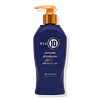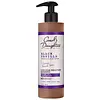What's inside
What's inside
 Key Ingredients
Key Ingredients

No key ingredients
 Benefits
Benefits

 Concerns
Concerns

 Ingredients Side-by-side
Ingredients Side-by-side

Cyclopentasiloxane
EmollientDimethiconol
EmollientHydrolyzed Keratin
HumectantPrunus Amygdalus Dulcis Oil
Skin ConditioningMauritia Flexuosa Fruit Oil
Skin ConditioningCinnamidopropyltrimonium Chloride
Argania Spinosa Kernel Oil
EmollientIsohexadecane
EmollientAlpha-Isomethyl Ionone
PerfumingPolysilicone-15
UV FilterKeratin Amino Acids
Skin ConditioningOenothera Biennis Oil
EmollientSesamum Indicum Seed Oil
EmollientParfum
MaskingLinalool
PerfumingHexyl Cinnamal
PerfumingButylphenyl Methylpropional
PerfumingHydroxyisohexyl 3-Cyclohexene Carboxaldehyde
MaskingCitronellol
PerfumingLimonene
PerfumingBenzyl Benzoate
AntimicrobialCyclopentasiloxane, Dimethiconol, Hydrolyzed Keratin, Prunus Amygdalus Dulcis Oil, Mauritia Flexuosa Fruit Oil, Cinnamidopropyltrimonium Chloride, Argania Spinosa Kernel Oil, Isohexadecane, Alpha-Isomethyl Ionone, Polysilicone-15, Keratin Amino Acids, Oenothera Biennis Oil, Sesamum Indicum Seed Oil, Parfum, Linalool, Hexyl Cinnamal, Butylphenyl Methylpropional, Hydroxyisohexyl 3-Cyclohexene Carboxaldehyde, Citronellol, Limonene, Benzyl Benzoate
Water
Skin ConditioningDisodium Laureth Sulfosuccinate
CleansingCocamidopropyl Betaine
CleansingSodium Lauryl Sulfoacetate
CleansingParfum
MaskingSodium Chloride
MaskingPolyquaternium-10
Polysorbate 20
EmulsifyingPhenoxyethanol
PreservativeHexylene Glycol
EmulsifyingCaprylyl Glycol
EmollientGlyceryl Caprylate
EmollientPEG-150 Distearate
EmulsifyingPolyquaternium-7
Benzyl Salicylate
PerfumingCoumarin
PerfumingBenzoic Acid
MaskingPotassium Sorbate
PreservativePEG-150 Stearate
Potassium Hydroxide
BufferingBenzyl Alcohol
PerfumingCaramel
Cosmetic ColorantGlycerin
HumectantPEG-150
HumectantStearic Acid
CleansingSodium Benzoate
MaskingAloe Barbadensis Leaf Juice
Skin ConditioningCitric Acid
BufferingLimonene
PerfumingBenzyl Benzoate
AntimicrobialRosa Canina Flower Extract
AstringentLavandula Angustifolia Flower Extract
CleansingUrtica Dioica Leaf Extract
Skin ConditioningRosmarinus Officinalis Leaf Extract
AntimicrobialCalendula Officinalis Flower Extract
MaskingMelilotus Officinalis Extract
AstringentSalvia Officinalis Extract
AntimicrobialVanilla Planifolia Fruit Extract
Skin ConditioningPEG-200 Hydrogenated Glyceryl Palmate
CleansingPEG-7 Glyceryl Cocoate
EmulsifyingWater, Disodium Laureth Sulfosuccinate, Cocamidopropyl Betaine, Sodium Lauryl Sulfoacetate, Parfum, Sodium Chloride, Polyquaternium-10, Polysorbate 20, Phenoxyethanol, Hexylene Glycol, Caprylyl Glycol, Glyceryl Caprylate, PEG-150 Distearate, Polyquaternium-7, Benzyl Salicylate, Coumarin, Benzoic Acid, Potassium Sorbate, PEG-150 Stearate, Potassium Hydroxide, Benzyl Alcohol, Caramel, Glycerin, PEG-150, Stearic Acid, Sodium Benzoate, Aloe Barbadensis Leaf Juice, Citric Acid, Limonene, Benzyl Benzoate, Rosa Canina Flower Extract, Lavandula Angustifolia Flower Extract, Urtica Dioica Leaf Extract, Rosmarinus Officinalis Leaf Extract, Calendula Officinalis Flower Extract, Melilotus Officinalis Extract, Salvia Officinalis Extract, Vanilla Planifolia Fruit Extract, PEG-200 Hydrogenated Glyceryl Palmate, PEG-7 Glyceryl Cocoate
 Reviews
Reviews

Alternatives
Ingredients Explained
These ingredients are found in both products.
Ingredients higher up in an ingredient list are typically present in a larger amount.
Benzyl Benzoate is usually created from the condensation of benzoic acid and benzyl alcohol. It is used as a preservative, solvent, and has a floral/balsamic scent in large amounts.
As a preservative, Benzyl Benzoate works against bacteria and fungus. It is often used to treat scabies and lice in medicine.
Solvents are used to keep ingredients together in a product. They can help dissolve ingredients to stable bases or help evenly distribute ingredients throughout the product.
Due to its fragrance, Benzyl Benzoate can be sensitizing and may cause contact dermatitis. It is a known EU allergen. We recommend speaking with a professional if you have any concerns.
Benzyl Benzoate can be naturally found in cranberries and peaches.
Learn more about Benzyl BenzoateLimonene is a fragrance that adds scent and taste to a formulation.
It's found in the peel oil of citrus fruits and other plants such as lavender and eucalyptus. The scent of limonene is generally described as "sweet citrus".
Limonene acts as an antioxidant, meaning it helps neutralize free radicals.
When exposed to air, oxidized limonene may sensitize the skin. Because of this, limonene is often avoided by people with sensitive skin.
The term 'fragrance' is not regulated in many countries. In many cases, it is up to the brand to define this term. For instance, many brands choose to label themselves as "fragrance-free" because they are not using synthetic fragrances. However, their products may still contain ingredients such as essential oils that are considered a fragrance.
Learn more about LimoneneParfum is a catch-all term for an ingredient or more that is used to give a scent to products.
Also called "fragrance", this ingredient can be a blend of hundreds of chemicals or plant oils. This means every product with "fragrance" or "parfum" in the ingredients list is a different mixture.
For instance, Habanolide is a proprietary trade name for a specific aroma chemical. When used as a fragrance ingredient in cosmetics, most aroma chemicals fall under the broad labeling category of “FRAGRANCE” or “PARFUM” according to EU and US regulations.
The term 'parfum' or 'fragrance' is not regulated in many countries. In many cases, it is up to the brand to define this term.
For instance, many brands choose to label themselves as "fragrance-free" because they are not using synthetic fragrances. However, their products may still contain ingredients such as essential oils that are considered a fragrance by INCI standards.
One example is Calendula flower extract. Calendula is an essential oil that still imparts a scent or 'fragrance'.
Depending on the blend, the ingredients in the mixture can cause allergies and sensitivities on the skin. Some ingredients that are known EU allergens include linalool and citronellol.
Parfum can also be used to mask or cover an unpleasant scent.
The bottom line is: not all fragrances/parfum/ingredients are created equally. If you are worried about fragrances, we recommend taking a closer look at an ingredient. And of course, we always recommend speaking with a professional.
Learn more about Parfum